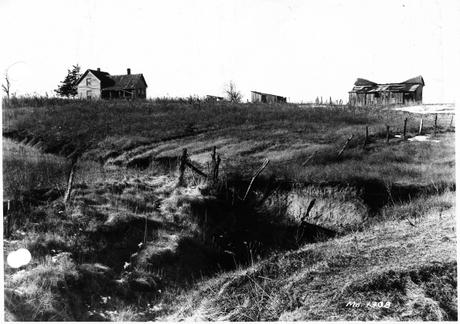GR: This is an urgent message that everyone should receive: We must act to stop the global deterioration and loss of forests, shrublands, grasslands, soil, and wildlife. Human activities–plowing the land, cutting the forests, grazing the grassland, warming the air, and exposing soil to wind and water erosion–are destroying our planetary life-sustaining ecosystems. Over the 40-year period to 2012, more than half the animals on Earth disappeared. Unless we make an immediate and powerful response, vegetation and soil losses will continue until they strip the planet’s surface bare. Without soil, much of the Earth will become as lifeless as the moon. Barren and silent but for whispering wind, pockets of weeds, clouds of wildfire smoke, and the distant cries of a few remaining animals.

Bessie Parker farm, Leon, Iowa. The erosion in these fields has reduced the value of the farm to the point where all but 40 acres have been taken over for taxes. Erosion has not stopped. Cattle grazing and sporadic hay mowing will continue to expose soil (photo: public domain, U. S. National Archives).
The source of the information on wildlife decline is the World Wildlife Fund: “Global biodiversity is declining at an alarming rate, putting the survival of other species and our own future at risk. The latest edition of WWF’s Living Planet Report brings home the enormity of the situation – and how we can start to put it right. The Living Planet Index reveals that global populations of fish, birds, mammals, amphibians and reptiles declined by 58 per cent between 1970 and 2012. We could witness a two-thirds decline in the half-century from 1970 to 2020 . . .”

Without soil, there will be no farms, freshwater will runoff to the sea, vegetation will disappear, and wildlife will die (photo © Kelly Sillaste / Getty Images / WWF).
Wildlife decline: Living Planet Report 2016 | WWF

